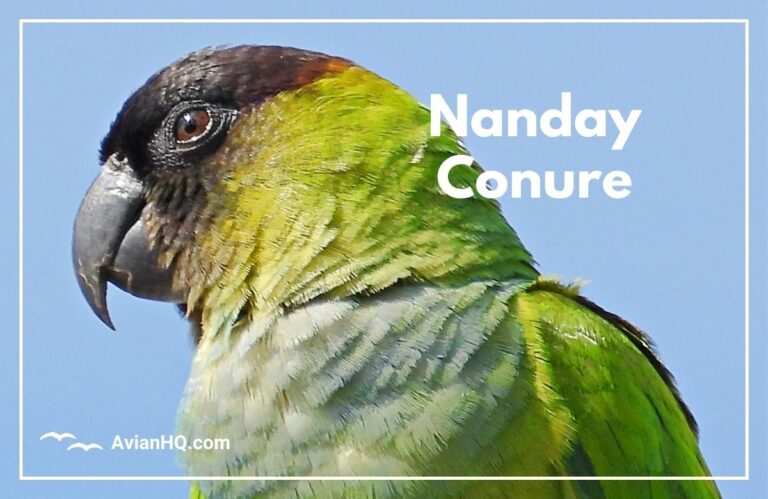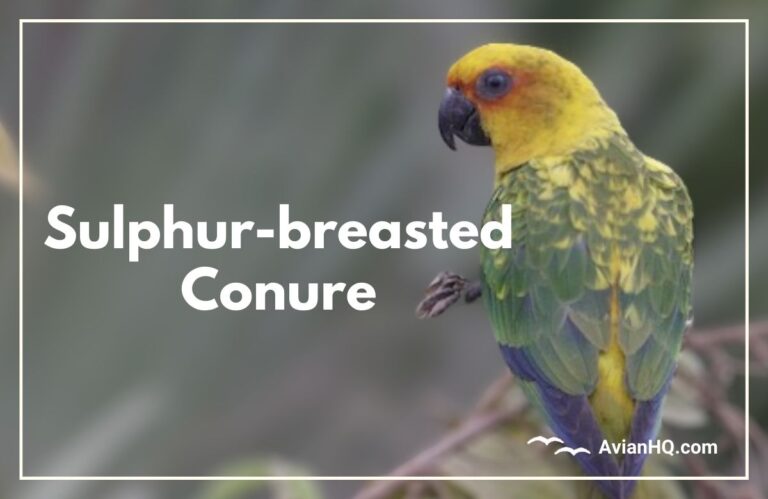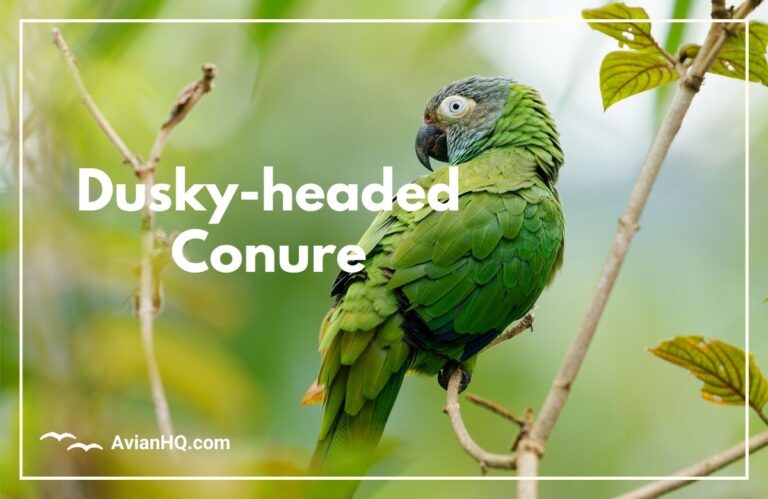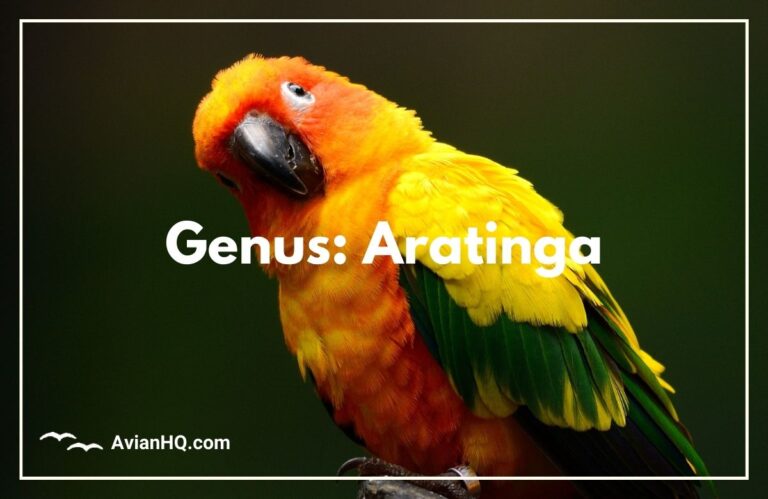Golden-capped Parakeet (Aratinga auricapillus)
As you gaze up into the rainforest canopies of Brazil, Bolivia, and Paraguay, you may catch a glimpse of vibrant green feathers and striking golden caps peeking through the leaves. These belong to the Golden-capped Parakeet, one of the most dazzling avian species found in South America’s lush forests.
“The Golden-capped Parakeet holds significance as an integral part of its ecosystem, a culturally iconic species, and a conservation priority.”
With its vivid plumage and status as a popular exotic pet, the parakeet has captivated people worldwide. However, few fully grasp the ecological role and behavior of this remarkable bird in the wild. As you will discover in this article, the Golden-capped Parakeet holds significance as an integral part of its ecosystem, a culturally iconic species, and a conservation priority.
Belonging to the diverse parrot family, this parakeet averages 9-11 inches (25-29 cm) with predominantly bright green feathers covering its body, wings of deep blue shades, tail feathers ranging from green to blue, and of course – the brilliant golden-yellow cap on its head that gives this species its name. While superficially similar to other parakeets, the Golden-capped has evolved specialized physical and behavioral adaptations to the humid rainforest habitats of South America.
By learning about the taxonomy, diet, breeding ecology and threats facing the Golden-capped Parakeet, you will not only gain insight into an extraordinary bird but hopefully be inspired to support conservation efforts as well.
History and Taxonomy
The vibrant beauty of the Golden-capped Parakeet first caught the attention of early European explorers and naturalists in South America in the 18th century. However, it was not officially described as a distinct species until 1856 by German naturalist Johann Hermann, who gave it the scientific name Conurus auricapillus. Since then, evolutionary research has traced its ancestry and reclassified it to its current designation – Aratinga auricapillus.
Scientific Classification
As a true parrot in the diverse order Psittaciformes, the Golden-capped Parakeet belongs to the family Psittacidae. More specifically, it is grouped under the genus Aratinga, which includes other small to medium sized parakeets and macaws native to Central and South America. The Golden-capped Parakeet’s full scientific classification is:
Kingdom: Animalia
Phylum: Chordata
Class: Aves
Order: Psittaciformes
Family: Psittacidae
Genus: Aratinga
Species: auricapillus
Evolutionary History
Analysis of fossil records, anatomy and genetics indicates Aratinga auricapillus shares common ancestry with a lineage of South American parakeets diverging 20-25 million years ago. It displays physical and behavioral traits well-adapted to its arboreal habitat in rainforest canopies. Over time, reproductive isolation and specialization led to it becoming the vibrant distinct species we know today.
Subspecies
There are three recognized subspecies of the Golden-capped Parakeet which can be distinguished by slight variations in size, plumage color and geographic range:
- A. a. auricapillus – Nominate subspecies found in southeast Brazil.
- A. a. aurifrons – Native to eastern Bolivia and western Brazil. Displays more yellow-orange on forehead.
- A. a. chrysopogon – Found in Paraguay. Overall paler green plumage.
Physical Appearance
The vibrant coloring and distinctive markings of the Golden-capped Parakeet set it apart from other parrot species. Its bright plumage is well-adapted to blend in with the tropical foliage of its canopy habitat.
Vibrant Green Plumage
Both sexes of Golden-capped Parakeets display predominantly grass green feathers covering their bodies, with a brighter lime-yellow green on the underparts and rump. The green hues provide camouflage amongst leaves when the parakeet is roosting or nesting high in the treetops.
Distinctive Golden Cap
As the name suggests, the most eye-catching feature of the Golden-capped Parakeet is the vibrant golden-yellow cap on the crown of its head. The golden cap is more extensive in male parakeets. It may serve an ornamental purpose in attracting mates.
Blue Wings
Contrasting beautifully with its grassy green body, the Golden-capped Parakeet has primary coverts and flight feathers in shades of deep blue to turquoise blue. Both males and females showcase this wing coloration.
Size and Weight
The Golden-capped Parakeet averages 9-11 inches (25-29 cm) in length with a wingspan around 10 inches (25 cm). It is relatively slim, weighing 2.5-3.6 ounces (70-100 grams). Females tend to be slightly smaller in size compared to males.
Bill, Eyes and Feet
In addition to its vibrant plumage, the Golden-capped Parakeet can be identified by key facial features. Its eyes are brown with pale eye-rings, and its bill is pale grey. Its feet are a pinkish-grey color with long claws adapted for grasping and climbing.
Habitat and Distribution
Native Range and Habitat
The Golden-capped Parakeet is endemic to the tropical regions of South America, primarily the Amazon basin. Its range spans parts of southeastern Brazil, eastern Bolivia and western Paraguay.
Within this region, it inhabits humid rainforests and woodlands, ranging from lowland plains up to elevations of 3,000 feet (915 meters). It resides mainly in sub-canopy and canopy layers of tall trees.
Introduced Populations
Small introduced populations of escaped captive Golden-capped Parakeets have become established in isolated parts of São Paulo, Brazil as well as Puerto Rico. However, their long-term impact on local ecosystems remains unknown.
Altitude Ranges
Throughout its native range, the Golden-capped Parakeet can adapt to various altitudes and forest types:
- Lowlands: Occurs in tropical and subtropical moist forests up to 1,000 feet (300 m).
- Hill country: Inhabits foothill areas between 1,000-3,000 feet (300-915 m).
- Mountain regions: Will sometimes range above 3,000 feet (915 m) along slopes with adequate vegetation.
The parakeet’s ability to occupy diverse altitudes and forest ecosystems contributes to its widespread distribution across Brazil, Bolivia and Paraguay.
Diet and Feeding
The Golden-capped Parakeet is opportunistic in its eating habits, feeding on a diverse mix of fruits, seeds, berries, nuts and flowers. It utilizes its strong beak to forage for food in treetops and foliage.
Overview of Diet in Wild
As an omnivore, the Golden-capped Parakeet feeds on both plant and some animal matter. The bulk of its diet consists of:
- Fruits and berries
- Flowers and nectar
- Tree nuts and seeds
- Occasionally insects, spiders and snails
It supplements its herbivorous feeding with small arthropods, ingesting important amino acids absent from plant foods alone.
Types of Foods Consumed
The species takes advantage of a wide assortment of rainforest food sources:
Fruits/Berries: Fig, mango, blackberry, raspberry, citrus
Seeds/Nuts: Palm, cedar, pine nut, chestnut
Flowers/Nectar: Bauhinia, Calliandra, Poincianella, Erythrina
Arthropods: Beetles, caterpillars, snails
Feeding Behaviors
The parakeet can often be seen foraging in small groups, using its slim beak tip to extract pieces of flesh from thick-skinned fruits. It holds larger fruits securely with its feet while feeding. When targeting seeds or nuts, it cracks them efficiently with its strong beak.
Breeding and Reproduction
The breeding season for the Golden-capped Parakeet varies across its range, typically occurring between September to March when food sources are abundant.
Nesting Sites
Golden-capped Parakeets nest in tree cavities, either natural holes or abandoned woodpecker nests. They prefer tall trees including palm trees. Both the male and female partner to build a nest lined with wood chips and debris 30-50 feet (9-15 meters) high up inside the chosen cavity.
Clutch Size
The female Golden-capped Parakeet lays a clutch of 3-5 small white eggs. The eggs measure roughly 1 inch (2.5 cm) long. She deposits one egg every 1-2 days until her clutch is complete.
Incubation and Fledging
Only the female incubates the eggs, keeping them warm beneath her body while the male stands guard. After 24-25 days, the eggs hatch. Both parents share duties feeding the young nestlings regurgitated food. Chicks leave the nest at 8 weeks old but remain dependent on parental care for another few weeks. They are sexually mature by 18 months old.
Behavior and Ecology
The Golden-capped Parakeet exhibits a range of interesting behaviors and plays an integral ecological role in its rainforest habitat.
Flock Sizes
Golden-capped Parakeets are highly social, spending most of their time roaming and feeding in noisy flocks numbering 10 to 30 individuals. In some cases during the non-breeding season, flocks may congregate in groups over 100 strong when food is concentrated.
Roosting Patterns
At night, flocks roost communally in cavities of tall rainforest trees. Social roosting sites are reused year after year and defended as valuable territory. Hundreds of parakeets may squeeze together on a single roost tree.
Foraging and Feeding Behaviors
The parakeets spend much of their day foraging for food in canopy and sub-canopy levels. Their strong beaks are adapted for extracting seeds and opening tough fruit. They move acrobatically through branches using their nimble feet and long tails for balance.
Interactions with Other Species
The Golden-capped Parakeet maintains complex relationships with other fauna. It competes with monkeys, toucans and parrots for food resources and prime nesting sites within overlapping forest habitats. Yet it also facilitates seed dispersal for a diversity of plants. Its nest cavities provide refuge to other cavity-dwelling creatures once abandoned. And despite serving as prey for tree-climbing predators, it continues thriving across its range.
Conservation Status
Currently, the Golden-capped Parakeet has a global population estimated between 10,000 to 19,999 mature individuals. While still relatively abundant throughout much of its range, the species does face growing threats primarily from habitat destruction and the wildlife trade.
IUCN Status
The IUCN Red List classifies the Golden-capped Parakeet as Least Concern presently. However local rates of forest loss and illegal poaching for the pet industry across South America could soon elevate its status to Vulnerable.
Population Trends
Studies suggest Golden-capped Parakeet numbers decreased 15-25% between 1994 to 2018. Researchers predict if current deforestation rates persist in the Amazon, the total population may further decline by 30-49% over the next three generations.
Major Threats
The conversion of rainforest to farms and mining, as well as continuing rates of poaching, represent the two most severe threats facing Golden-capped Parakeets:
Habitat loss: Forest fragmentation from fires, agriculture and development disrupts nesting and feeding grounds.
Illegal pet trade: An estimated 46,000 parakeets are still poached from the wild yearly to meet consumer demand for rare pets, depleting wild stocks.
Conservation Efforts
While not yet featured in targeted action plans, the Golden-capped Parakeet warrants more concerted efforts to guarantee its future viability given the rapid pace of threats. Expanding protected areas and increasing enforcement against poaching will be critical in the coming decades.
Cultural Significance
The vibrant colors and behaviors of the Golden-capped Parakeet have made them admired fixtures in both the ecological landscape and cultural fabric of communities across their native range.
Folklore and Indigenous Beliefs
For indigenous groups like the Guarani people of Paraguay, the Golden-capped Parakeet holds special meaning in tribal mythology where it is seen as a noble forest spirit. Its bright feathers also decorate ceremonial dress and tribal artworks. Some groups use the parakeets’ tail feathers to fletch hunting arrows.
Iconic Species in Art and Media
The brilliant plumage and crown of the Golden-capped Parakeet inspire its depiction across various art forms. It is a favorite subject of wildlife painters and bird illustrators across South America. Wood carvings and pottery featuring its likeness also abound in local markets.
As a prominent rainforest bird, the Golden-capped Parakeet serves as an unofficial mascot for conservation initiatives from the Amazon Basin to the Atlantic Forest. Its ubiquity makes it a charismatic ambassador that helps spotlight broader environmental awareness campaigns.
Tourism
In protected reserves where it occurs, birdwatching tourists eagerly add the Golden-capped Parakeet as a highlight sighting. Across Brazil, Bolivia and Paraguay, busy flocks draw crowds at clay licks or fruiting trees. The species contributes substantially as an ecotourism attraction that boosts local economies through associated tourism activities.
Conclusion
As we have explored, the Golden-capped Parakeet is far more than just a flashy, tropical bird. It is an integral resident of South American rainforests that has captivated the fascination of both scientists and artists alike.
With its specialized adaptations, critical ecological role, and cultural symbolism, the Golden-capped Parakeet epitomizes the wondrous biodiversity of our planet. Yet like so many wild species, it now faces escalating threats from habitat destruction and illegal trafficking demands.
While still currently ranked Least Concern, the Golden-capped Parakeet warrants greater habitat protections and enforcement of wildlife regulations across Brazil, Bolivia and Paraguay before population declines become irreversible.
If successfully conserved over the next crucial decades, hopefully future generations will continue enjoying sightings of vibrant green, blue and gold fluttering through rainforest leaves. The survival of the Golden-capped Parakeet ultimately rests in our hands – by preserving species, we preserve entire ecosystems and ourselves.







